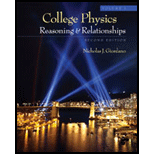
Concept explainers
(a)
The velocity of the object as a function of time.
(a)
Answer to Problem 36P
The velocity of the object as a function of time is
Explanation of Solution
Write the equation for the acceleration over a given time.
Here,
Conclusion:
Substitute
The velocity at
It is a constant acceleration of
Hence,
Therefore, write the velocity of the object as a function of time.
(b)
The velocities of the object.
(b)
Answer to Problem 36P
The new velocities of the object are
Explanation of Solution
The initial velocity here is
Conclusion:
Therefore, the new velocities are
And
Want to see more full solutions like this?
Chapter 2 Solutions
College Physics, Volume 1
- A racing car starts from rest at t = 0 and reaches a final speed at time t. II the acceleration of the car is constant during this time, which of the following statements are true? (a) The car travels a distance t. (b) The average speed of the car is /2. (c) The magnitude of the acceleration of the car is /t. (d) The velocity of the car remains constant, (e) None of statements (a) through (d) is true.arrow_forwardFigure P2.15 shows a graph of vx versus t for the motion of a motorcyclist as he starts from rest and moves along the road in a straight line. (a) Find the average acceleration for the time interval t = 0 to t = 6.00 s. (b) Estimate the time at which the acceleration has its greatest positive value and the value of the acceleration at that instant. (c) When is the acceleration zero? (d) Estimate the maximum negative value of the acceleration and the time at which it occurs. Figure P2.15arrow_forward1 A 2000 kg car accelerates from 28 m/s to a stop in 45 m. Determine the magnitude of the average acceleration during that time. Group of answer choices 9.8 m/s2 8.7 m/s2 1.3 m/s2 6.5 m/s2arrow_forward
- If the brakes on a car can give the car a constant negative acceleration 2k m/s^2 where k is positive constant. What is the greatest speed it may be going if it is necessary to be able to stop the car within 25 meters after the brakes are applied Choices: A) 20/✓k m/s B) 5k m/s C) 10✓k m/s D) 25k^2 m/sarrow_forwardA European sports car dealer claims that his product will accelerate at a constant rate from rest to a speed of 100 km/hr in 8.00 s. What is the speed after the first 4.00 s of acceleration? (Hint: First convert the speed to m/s.)arrow_forwardA racing enthusiast claims that his sports car will accelerate from rest to a speed of 40.0 m/s in 8.10 s. (a) Determine the magnitude of the average acceleration of the car (in m/s2). m/s2 (b) Assume that the car moves with constant acceleration. Find the distance (in m) the car travels in the first 8.10 s. m (c) What is the speed of the car (in m/s) 10.0 s after it begins its motion if it continues to move with the same acceleration? m/sarrow_forward
- A Honda Civic travels in a straight line along a road. Its distance x from a stop sign is given as a function of time t by the equation x(t) = αt2−βt3, where α = 1.55 m/s2 and β = 0.0520 m/s3. a. Calculate the average velocity of the car for the time interval t = 0 to t = 1.95 s. b. Calculate the average velocity of the car for the time interval t = 0 to t = 4.00 s. c. Calculate the average velocity of the car for the time interval t = 1.95 s to t = 4.00 s.arrow_forwardA ball slides across the floor with an initial velocity of 3.0 m/s. What is its average acceleration if it stops after 120 s? a. -0.075 m/s² b. -0.025 m/s² c. +0.025 m/s² d. +0.075 m/s²arrow_forwardA collector of antique sports cars claims that her sports car will accelerate from rest to a speed of 50.0 m/s in 8.60 s. (a) Determine the magnitude of the average acceleration of the car (in m/s2). m/s2 (b) Assume that the car moves with constant acceleration. Find the distance (in m) the car travels in the first 8.60 s. m (c) What is the speed of the car (in m/s) 10.0 s after it begins its motion if it continues to move with the same acceleration? m/sarrow_forward
- A rocket-powered sled moves along a track, eventually reaching a top speed of 150 m/s to the west. It then begins to slow down, reaching a complete stop after slowing down for 4.21 s. What was the sled s average acceleration and velocity during the slowdown phase? 35.6 m/s^2 east, not enough information 0 m/s^2 0, 75 m/s west 35.6 m/s^2 west, not enough informationarrow_forwardThe velocity vs time graph for an object is shown. How far has it gone in 4.5 seconds starting at t = 0s? The figure shows the velocity versus time graph for an object. From t = -3 to 0s, the velocity is constant at 45 m/s. From t=0 to 4.5s, velocity decreases linearly from 45 m/s to 0 m/s. 101 m 225 m 150 m 112 marrow_forwardWhat is the final velocity of a ball dropped into free fall from rest after a time of 2.00 s? (Let g= the acceleration due to gravity) a. g b. 3g c. -2g d. 4g e. Zeroarrow_forward
 Physics for Scientists and Engineers, Technology ...PhysicsISBN:9781305116399Author:Raymond A. Serway, John W. JewettPublisher:Cengage Learning
Physics for Scientists and Engineers, Technology ...PhysicsISBN:9781305116399Author:Raymond A. Serway, John W. JewettPublisher:Cengage Learning Principles of Physics: A Calculus-Based TextPhysicsISBN:9781133104261Author:Raymond A. Serway, John W. JewettPublisher:Cengage Learning
Principles of Physics: A Calculus-Based TextPhysicsISBN:9781133104261Author:Raymond A. Serway, John W. JewettPublisher:Cengage Learning

